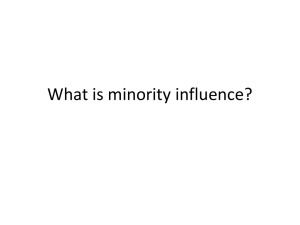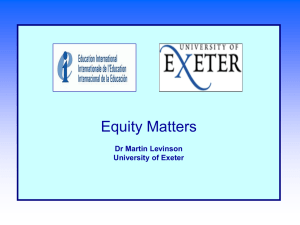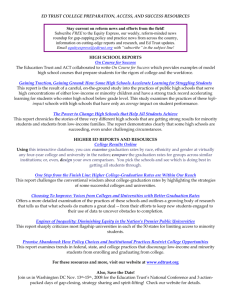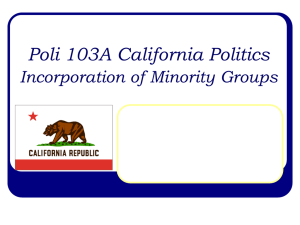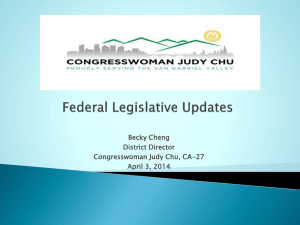SIFMA`s Diversity Recruitment Practices
advertisement
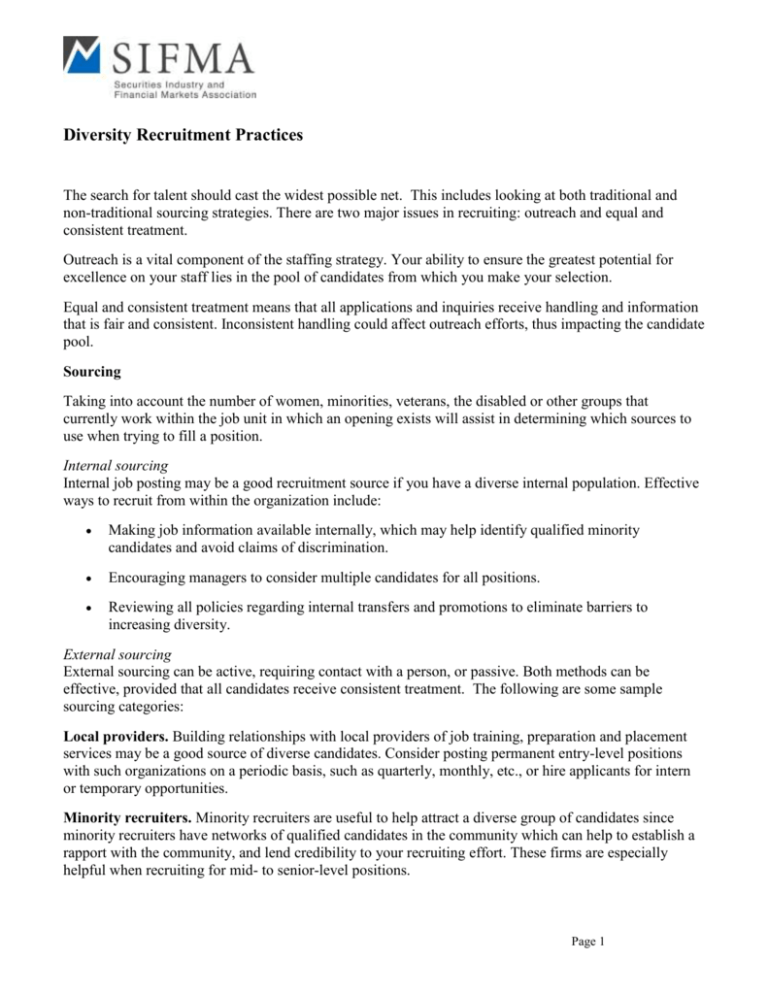
Diversity Recruitment Practices The search for talent should cast the widest possible net. This includes looking at both traditional and non-traditional sourcing strategies. There are two major issues in recruiting: outreach and equal and consistent treatment. Outreach is a vital component of the staffing strategy. Your ability to ensure the greatest potential for excellence on your staff lies in the pool of candidates from which you make your selection. Equal and consistent treatment means that all applications and inquiries receive handling and information that is fair and consistent. Inconsistent handling could affect outreach efforts, thus impacting the candidate pool. Sourcing Taking into account the number of women, minorities, veterans, the disabled or other groups that currently work within the job unit in which an opening exists will assist in determining which sources to use when trying to fill a position. Internal sourcing Internal job posting may be a good recruitment source if you have a diverse internal population. Effective ways to recruit from within the organization include: Making job information available internally, which may help identify qualified minority candidates and avoid claims of discrimination. Encouraging managers to consider multiple candidates for all positions. Reviewing all policies regarding internal transfers and promotions to eliminate barriers to increasing diversity. External sourcing External sourcing can be active, requiring contact with a person, or passive. Both methods can be effective, provided that all candidates receive consistent treatment. The following are some sample sourcing categories: Local providers. Building relationships with local providers of job training, preparation and placement services may be a good source of diverse candidates. Consider posting permanent entry-level positions with such organizations on a periodic basis, such as quarterly, monthly, etc., or hire applicants for intern or temporary opportunities. Minority recruiters. Minority recruiters are useful to help attract a diverse group of candidates since minority recruiters have networks of qualified candidates in the community which can help to establish a rapport with the community, and lend credibility to your recruiting effort. These firms are especially helpful when recruiting for mid- to senior-level positions. Page 1 Employee referrals. Referrals from employees and recent hires that may know good candidates for current open positions may be another fruitful avenue to pursue. A satisfied employee can be one of your best recruiters. This practice may increase access and visibility to qualified minority candidates by increasing the general applicant pool. Minority media advertising. Advertising job opportunities in local minority newspapers, on local radio stations and at company-sponsored open houses, may assist in attracting qualified diverse candidates. Minority special interest groups. When appropriate, post openings with special interest groups or associations that have a minority membership (e.g., Black MBA or Black Accountants). Minority job fairs. Local minority job fairs, such as those sponsored by the NAACP, the local Hispanic Chamber of Commerce, the local Black MBA or other targeted providers, may provide opportunities to promote employment at your company to an expansive minority audience. Go where the grads are! According to data supplied by the U.S. Department of Education, minority enrollment in four-year private institutions is increasing at twice the rate of minority enrollment in fouryear public schools. Many employers say they recruit at the college level for the sake of efficiency. Essentially, diversifying a company from the ground up is often cheaper and, retention-wise, more effective than relying on “headhunters” and referrals. Many employers focus some of their recruiting efforts on colleges or universities that historically have attracted students from certain ethnic groups. Florida A & M, Spelman, Morehouse, Howard, and Hampton, for example, historically have attracted African-American students. Similarly, Stanford University, Santa Clara University and the University of California - Berkeley are a few examples of schools with a high percentage of Asian-American students, while Baruch College, CUNY, Kean College of NJ and Our Lady of the Lake University have, for example, a high percentage of Hispanic students. Effective recruiting tools include presentations on campus followed by a reception to expose students to your firm. More complete listings of colleges and universities with high concentrations of minorities, women, and gay and lesbian students, can be found in the sections of this site which cover each group. High school career-related events. Some employers find it useful to participate in local high school events such as career fairs, classroom presentations, and role model/career day educational seminars. While it is difficult to measure results, the exposure to your firm may make these students think about joining your company later. Corporate intern programs. A number of firms have developed formal internship programs that target a diverse group of high-caliber college students whose education and experience align with the needs of your company. The program can be designed to introduce participants to your business and corporate culture as a way to heighten their interest in the firm, and may include training, branch visits (if applicable) and interactions with company executives. Community intern programs. Community intern programs that focus on providing internship opportunities to high-caliber minority high school and/or college students are another valuable recruitment tool. Community and Educational Partnerships. Employers report that one of the keys to developing and maintaining a cache of minority talent and resources is to stay active in ethnic communities. Once these relationships have been established, your firm’s employment visibility in the community is likely to Page 2 improve, as will your success at finding and hiring qualified minority candidates. According to diversity professionals, minority candidates are particularly eager to work for a company they feel is committed to them. Community partnerships have been shown to be an excellent way to demonstrate this commitment. Something as simple as sponsoring a local high-school football team goes a long way in establishing recognition. Each community has its own local program or programs. However, many communities have similar organizations you might want to target to access diverse community partnerships. For instance, United Way programs offer diversity materials about a variety of non-profit programs in many local communities. One United Way agency has compiled, “Diversity - Best Practices,” which identifies agencies that serve a wide variety of diverse populations. Consider sponsoring The Stock Market GameTM. Sponsorship of The Stock Market Game (SMG) in minority communities is another excellent way to increase your firm’s local visibility, while at the same time, fostering the development of future minority investors and savers. An exciting, real-world simulation, SMG enables participants to discover the risks and rewards involved in decision-making, the sources and uses of capital, and other related economic concepts. Over the last 20 years, this program has helped more than six million students nationwide and in 15 other countries learn how financial markets work and how capital is raised to fund business growth. SMG is typically played by students in grades 4 through 12 as well as post-secondary students and others who want to learn more about investing and managing their financial future. Over the course of 10 weeks, participants invest a hypothetical $100,000 in Nasdaq, Amex, and NYSE-listed common stocks. They research stocks, study how the financial markets work, choose their portfolios, manage budgets, follow companies in the news, and make decisions on whether to buy, sell, or hold. They can compare their portfolios’ performance to peers on a weekly basis. Students are enthusiastic about SMG because of its realism, team-based decision-making, and genuine fun. Student team members collaborate to determine their own investment decisions and check their ranking weekly versus all state teams in their division. SMG is a trademarked program of the Foundation for Investor Education. Since 1977, the program has given educators a way to improve the learning experience in thousands of classrooms. Teachers have successfully used The Stock Market Game Program to enliven core academic subjects - including math, social studies, and language arts-and research has shown there's no better way to teach the importance of saving and investing. To learn more about SMG and how to facilitate its use in your local schools, consult www.smgww.org to ascertain the identity of the local coordinator for your area. Local divisions of national organizations. Local chapters of larger organizations are also a good source for partnership opportunities. Examples include NAACP, NASP, United Negro College Fund, Korean American Coalition, Hispanic Community Foundation, and the National Organization of Women. Partnership ideas with these organizations include representation on local chapter boards or committees or scholarships for designated college students. Economic development agencies. Another recruiting vehicle is to partner with economic development agencies. Local economic development agencies are often involved in a wide variety of activities to look at the overall economic picture of our community. As a result, they are integrated into a wide variety of programs, many of which support diverse communities. Board membership or other committee volunteerism can reveal partnering opportunities. Page 3


